The Only Lancer Charge in the Civil War

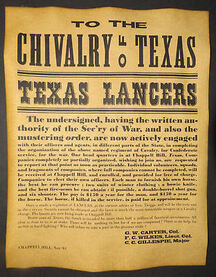 When Major General H. H. Sibley invaded New Mexico in 1862, he brought with him two companies of lancers.
When Major General H. H. Sibley invaded New Mexico in 1862, he brought with him two companies of lancers.Handsome and chivalrous heirs of medieval knights, the lancers were the darlings of the parade through San Antonio on the day the Army of New Mexico headed west. Bright red flags with white stars snapped from their lances. Lances had been common on Napoleonic battlefields, and were used by Mexican cavalry during the conflicts against the Texans in the 1830s and 1840s. The lances that these two companies carried were war trophies captured from the Mexicans during the Mexican American War thirteen years earlier
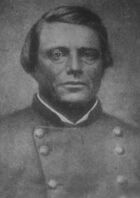 Colonel Thomas Green On the day of the Battle for Valverde Ford, Colonel Thomas Green peered across the battlefield and saw uniforms that he couldn't identify. Knowing they weren't Union regulars, he guessed that these men on the Union extreme right were a company of inexperienced New Mexico Volunteers who would break and run from a lancer charge.
Colonel Thomas Green On the day of the Battle for Valverde Ford, Colonel Thomas Green peered across the battlefield and saw uniforms that he couldn't identify. Knowing they weren't Union regulars, he guessed that these men on the Union extreme right were a company of inexperienced New Mexico Volunteers who would break and run from a lancer charge. He turned to the commanders of his two lancer companies, Captains Willis Lang and Jerome McCown, and asked which would like to have the honor of the first charge.
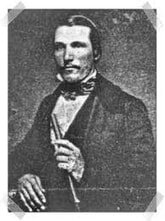 Captain Willis Lafayette Lang The first hand up belonged to the leader of the 5th Texas Cavalry Regiment's Company B. Captain Willis L. Lang was a rich, 31 year old who owned slaves that worked his plantation near Marlin in Falls County, Texas.
Captain Willis Lafayette Lang The first hand up belonged to the leader of the 5th Texas Cavalry Regiment's Company B. Captain Willis L. Lang was a rich, 31 year old who owned slaves that worked his plantation near Marlin in Falls County, Texas. Lang quickly organized his men. Minutes later, he gave the signal and his company cantered forward, lowered their lances, and began galloping across the 300 yards that divided his men from the men in the unusual uniforms. The plan called for McCown's company to follow after the Union troops had broken, and the two lancer companies would chase the panicking Union men into the Rio Grande that stood at their back.
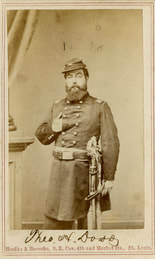 Captain Theodore Dodd But Colonel Green was wrong. The men in the strange uniforms were not New Mexican Volunteers. They were Captain Theodore Dodd’s Independent Company of Colorado Volunteers. Dodd's men were a scrappy collection of miners and cowboys who were reputedly low on discipline but high on fighting spirit. They coolly waited until the lancers were within easy range, then fired a volley that unhorsed many of the riders. Their second volley finished the assault. More than half of Lang's men were either killed or wounded, and most of the horses lay dead on the field. Lang himself dragged himself back to the Confederate lines because he was too injured to walk. Lang's charge was the only lancer charge of the American Civil War. The destruction of his company showed that modern firearms had rendered the ten-foot long weapons obsolete. McCown's men, and what remained of Lang's men threw their lances into a heap and burned them. They then rearmed themselves with pistols and shotguns and returned to the fight. The day after the battle, Lang and the rest of the injured Confederate were carried north to the town of Socorro, where they had requisitioned a house and turned it into a hospital. A few days later, depressed and in great pain, he asked his colored servant for his revolver, with which he ended his suffering. Lang and the other Confederate dead were buried in a plot of land near the south end of town that has now become neglected and trash-strewn. The owners do not allow visitors.
Captain Theodore Dodd But Colonel Green was wrong. The men in the strange uniforms were not New Mexican Volunteers. They were Captain Theodore Dodd’s Independent Company of Colorado Volunteers. Dodd's men were a scrappy collection of miners and cowboys who were reputedly low on discipline but high on fighting spirit. They coolly waited until the lancers were within easy range, then fired a volley that unhorsed many of the riders. Their second volley finished the assault. More than half of Lang's men were either killed or wounded, and most of the horses lay dead on the field. Lang himself dragged himself back to the Confederate lines because he was too injured to walk. Lang's charge was the only lancer charge of the American Civil War. The destruction of his company showed that modern firearms had rendered the ten-foot long weapons obsolete. McCown's men, and what remained of Lang's men threw their lances into a heap and burned them. They then rearmed themselves with pistols and shotguns and returned to the fight. The day after the battle, Lang and the rest of the injured Confederate were carried north to the town of Socorro, where they had requisitioned a house and turned it into a hospital. A few days later, depressed and in great pain, he asked his colored servant for his revolver, with which he ended his suffering. Lang and the other Confederate dead were buried in a plot of land near the south end of town that has now become neglected and trash-strewn. The owners do not allow visitors. 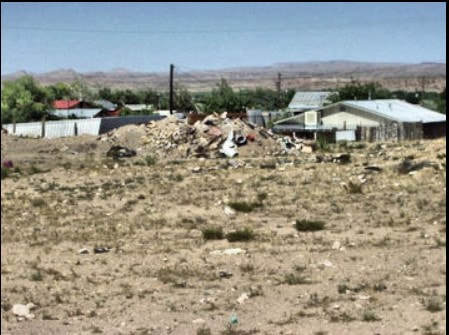 This derelict field was once a Confederate Cemetery.
This derelict field was once a Confederate Cemetery.
 The Charge of Company B of the 5th Texas Cavalry Regiment at the Battle of Valverde Ford is included in Jennifer Bohnhoff's historical novel, Valverde. The author is a former New Mexico history teacher who lives in the mountains of central New Mexico. You can read more about her and her writing here.
The Charge of Company B of the 5th Texas Cavalry Regiment at the Battle of Valverde Ford is included in Jennifer Bohnhoff's historical novel, Valverde. The author is a former New Mexico history teacher who lives in the mountains of central New Mexico. You can read more about her and her writing here.
Published on June 01, 2020 00:00
No comments have been added yet.



